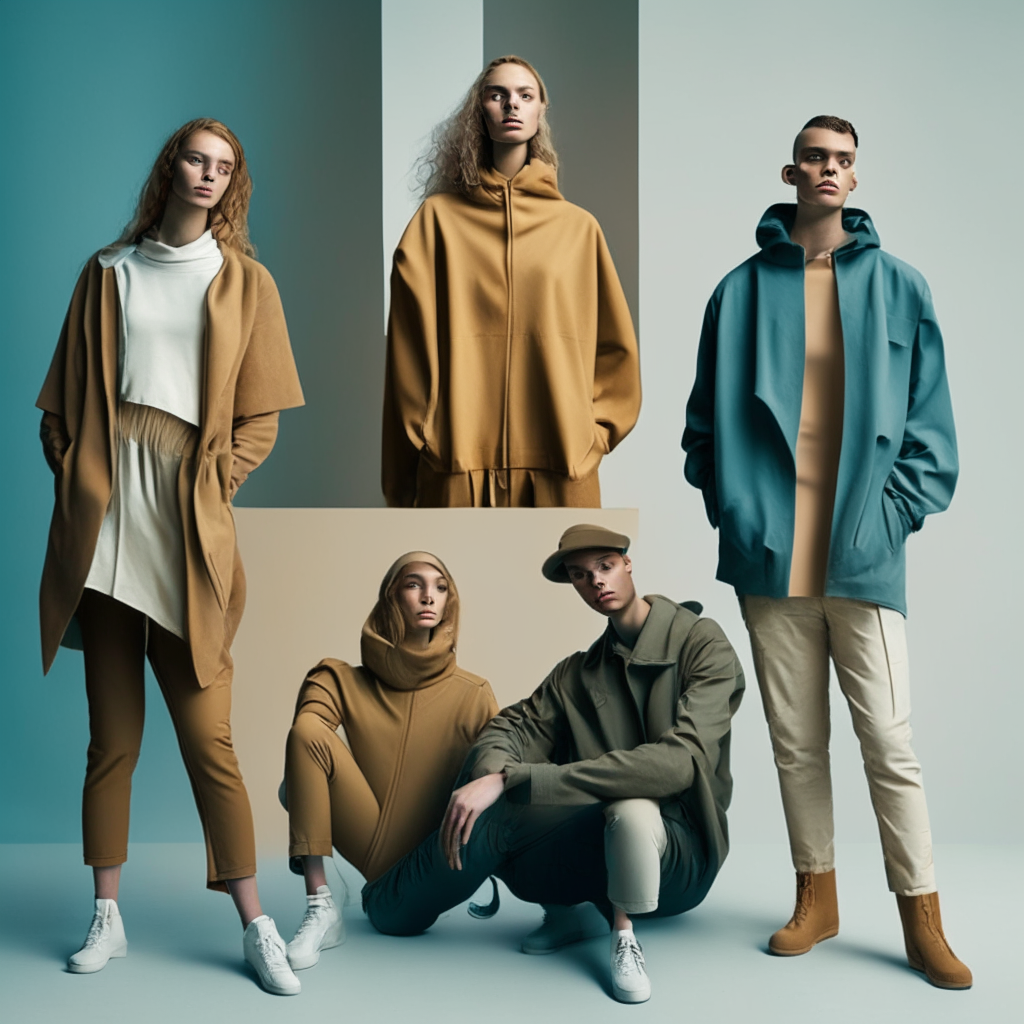The journey toward sustainable fashion is one of learning, adapting, and conscious decision-making. It’s about understanding the impact of our choices and making a deliberate effort to minimize harm while maximizing benefit. To help us on our journey, there’s a growing excitement regarding sustainable clothing brands.
Understanding Sustainable Fashion
Defining Sustainable Clothing
Sustainable clothing, or eco-fashion, isn’t just about the end product. It involves a holistic approach that considers every stage of the product’s life cycle – from sourcing raw materials to manufacturing, distribution, and disposal.
A few key characteristics of sustainable clothing include:
Eco-friendly Materials: Sustainable clothing utilizes materials that have a minimal environmental impact. This includes organic fibers, recycled materials, and low-impact dyes.
Ethical Labor Practices: Ensuring fair wages and good working conditions for everyone involved in the production process is crucial to sustainable fashion.
Longevity: Sustainable clothing is designed to last, encouraging a shift away from the fast-fashion model of ‘wear and discard.
The Importance of Sustainable Clothing
The need for sustainable clothing is becoming increasingly evident. Our current fashion consumption patterns are taking a heavy toll on the planet and its inhabitants.
From the excessive use of resources like water and energy to the pollution caused by non-biodegradable materials and toxic dyes, the environmental impact of fashion is profound.
In addition, the industry is rife with social issues, including unfair wages, poor working conditions, and even child labor.
By embracing sustainable clothing – including recycled shoes – we can help address these issues. We can reduce environmental harm, promote social justice, and drive the fashion industry toward a more sustainable future.
The Rise of Sustainable Clothing Brands
The Market Shift
The fashion industry is changing, and sustainable fashion brands are leading the charge. These brands are proving that it’s possible to create fashionable, affordable clothing without compromising ethics or the environment.
From using eco-friendly materials and adopting ethical labor practices to fostering transparency and supporting local communities, these brands are redefining what it means to be a fashion brand in the 21st century.
Consumer Demand
This shift towards sustainable fashion isn’t just being driven by the brands; consumers play a crucial role too.
More and more people are recognizing the importance of sustainable fashion. They’re seeking brands that align with their values and are willing to pay a premium for sustainable, ethically produced garments.
This growing consumer demand is driving more brands to adopt sustainable practices, creating a positive cycle of change.
Top Sustainable Clothing Brands You Should Know
Patagonia
Patagonia, a brand synonymous with sustainability, is committed to ethical and environmentally friendly practices.
What Makes Patagonia Sustainable?
Patagonia’s commitment to sustainability is evident in every aspect of its business. They use eco-friendly materials like organic cotton and recycled polyester. They’re transparent about their supply chains and ensure fair wages and good working conditions. They also donate a portion of their profits to environmental initiatives.
Everlane
Everlane is another brand that’s making waves in the sustainable fashion scene.
Everlane’s Approach to Sustainability
Everlane’s “Radical Transparency” ethos is at the heart of its approach to sustainability. They’re open about their costs, their factories, and their markups. They also prioritize the use of eco-friendly materials and ethical labor practices.
Stella McCartney
Luxury fashion is included in the sustainability movement, thanks to brands like Stella McCartney.
Sustainability at Stella McCartney
Stella McCartney has been a champion of sustainable fashion since the brand’s inception. They use eco-friendly materials, avoid fur and leather, and promote circularity in fashion.
Eileen Fisher
Eileen Fisher is a brand that combines sustainability and style seamlessly.
Eileen Fisher’s Commitment to Sustainability
Eileen Fisher uses organic and recycled materials, supports fair trade and human rights, and has a take-back program for their garments. They’re also committed to achieving 100% sustainability by 2030.
People Tree
People Tree is known for its fair-trade-certified collections.
People Tree’s Fair-Trade Practices
People Tree works with artisans and farmers in the developing world to create sustainable and ethically produced clothing. They use organic cotton and eco-friendly dyes, ensuring their garments are kind to people and the planet.
Take a Look at a Selection of Amazon’s Sustainable Clothing Brands hereHow to Choose Sustainable Clothing Brands
Material Considerations
Materials play a crucial role in sustainability. Look for brands that use organic, recycled, or otherwise eco-friendly and sustainable fabrics.
Sustainable Materials to Look For
Organic cotton, hemp, and recycled polyester are all excellent choices. Avoid synthetic fibers and conventionally grown cotton, which are harmful to the environment.
Manufacturing Practices
A brand’s manufacturing practices also impact its sustainability. Look for brands that minimize energy and water use, reduce waste, and avoid harmful chemicals.
Ethical Manufacturing in the Fashion Industry
Ethical manufacturing involves treating workers fairly, providing safe working conditions, and paying fair wages. It also means minimizing environmental impact through resource conservation and waste reduction.
Brand Values
Finally, consider the brand’s values. Do they prioritize transparency? Are they committed to social and environmental responsibility? Do they contribute to positive change?
Why Brand Values Matter
When you support a brand, you’re buying its products and endorsing its values. You can make a real difference by choosing brands with strong ethical and environmental values.
In-Depth Look at Sustainable Materials
Sustainable clothing brands prioritize the use of eco-friendly materials. Let’s dig a bit deeper into some of these materials:
- Organic Cotton: This is cotton grown without harmful pesticides and synthetic fertilizers, making it better for the environment and the farmers.
- Hemp: Hemp is a highly sustainable crop that requires little water and no pesticides. It’s also biodegradable and naturally resistant to mold and ultraviolet light.
- Recycled Polyester: This material is made from recycled plastic bottles, reducing waste and conserving resources.
- Linen: Linen is derived from the flax plant. It’s strong, naturally moth-resistant, and requires less water and pesticides than cotton.
- Tencel: This type of rayon is made from sustainably sourced wood pulp. It’s soft, breathable, and biodegradable.
The Importance of Ethical Manufacturing
Sustainable clothing isn’t just about the materials used; it’s also about how they are turned into garments. This is where ethical manufacturing comes in.
Ethical manufacturing involves ensuring fair wages and safe working conditions for workers. It also involves minimizing environmental impact through energy-efficient processes, waste reduction strategies, and avoiding harmful chemicals.
The Power of Transparency
Transparency is another crucial aspect of sustainable fashion. It involves openly sharing information about supply chains, manufacturing processes, and business practices.
A transparent brand empowers consumers to make informed decisions. It also holds the brand accountable, encouraging them to uphold high ethical and environmental standards.
Consumer Influence on Sustainable Clothing Brands
As consumers, we have a powerful influence on the fashion industry. Our purchasing decisions can drive brands to adopt more sustainable practices.
We can push the fashion industry towards a more sustainable future by supporting sustainable clothing brands. We can show that it’s not just about style and affordability – it’s also about ethics and sustainability.
Supporting Sustainable Fashion
Supporting sustainable fashion doesn’t have to be complicated or expensive. Here are a few simple ways to get started:
- Buy Less, Choose Well: Instead of buying lots of cheap, low-quality clothes, invest in fewer, higher-quality items that will last.
- Recycle or Upcycle: Instead of throwing away old clothes, consider recycling or upcycling them.
- Support Sustainable Brands: Choose to buy from brands that prioritize sustainability.
- Spread the Word: Talk to your friends and family about the importance of sustainable fashion.
Every small step towards sustainability makes a difference. Together, we can help create a more sustainable future for fashion.
Conclusion
Sustainable fashion isn’t just a trend – it’s a necessary shift towards a more ethical and eco-friendly lifestyle. You’re voting with your wallet for a better future by supporting sustainable clothing brands.
FAQs
1. What is sustainable clothing?
Sustainable clothing refers to garments designed, manufactured, distributed, and used in environmentally friendly and socially responsible ways. It involves a holistic approach considering every stage of the product’s lifecycle.
2. Why should I choose sustainable clothing brands?
Choosing sustainable clothing brands can reduce your environmental impact and support ethical labor practices. It’s a way to use your purchasing power for positive change.
3. How can I identify a sustainable clothing brand?
Look for brands that use eco-friendly materials, follow ethical manufacturing practices, prioritize transparency, and uphold strong values towards the environment and their workers. Also, check if they’re involved in any social or environmental initiatives.
4. Are sustainable clothing brands more expensive?
While some sustainable brands may be pricier due to the higher cost of eco-friendly materials and ethical manufacturing, many affordable options are also available. Plus, sustainable clothes are often more durable, offering better value for money in the long run.
5. Can sustainable clothing be stylish?
Absolutely! Many sustainable clothing brands offer a wide range of fashionable garments. Sustainability and style can definitely go hand in hand.
6. How does sustainable clothing impact the environment?
Sustainable clothing minimizes environmental impact by using eco-friendly materials, reducing waste, and employing energy-efficient manufacturing practices. It also promotes a circular economy by encouraging practices like recycling and upcycling.
7. What are some examples of sustainable materials?
Sustainable materials include organic cotton, hemp, recycled polyester, linen, Tencel, and many more. These materials are produced with minimal harm to the environment.
8. What does it mean when a brand is ‘transparent’?
A transparent brand openly shares information about its supply chains, manufacturing processes, and business practices. This allows consumers to make informed decisions about their purchases.
9. How does consumer demand influence sustainable fashion?
Consumer demand plays a crucial role in driving the shift toward sustainable fashion. As more consumers prefer eco-friendly and ethically produced clothing, more brands are motivated to adopt sustainable practices.
10. How can I support sustainable fashion?
You can support sustainable fashion by buying from sustainable brands, opting for quality over quantity, recycling or upcycling your clothes, and spreading awareness about sustainable fashion. Every small step counts. By making more conscious choices, we can collectively make a big difference.





Pingback: Sustainable Fabrics: Charting the Course for Eco-Friendly Fashion
Pingback: Eco Friendly Laundry Detergent: Why and How to Make the Switch
Pingback: What Is Sustainability? Unlocking the Power to Transform Our World
Pingback: Sustainable Fashion Brands: Redesigning Style Responsibly
Pingback: Recycled Shoes: A Step Towards a Sustainable Future
Pingback: Sustainable Jewelry: The Future of Ethical Fashion - Eco Life Wise
Pingback: Sustainable Shoe Brands: A Step Towards a Greener Future
Pingback: Eco Friendly Toilet Paper: A Cheeky Guide to Going Green
Pingback: Sustainable Swimwear: A Deep Dive Into Eco Friendly Choices
Pingback: Unlock the Secret to Affordable Sustainable Clothing
Pingback: Upcycled Clothing: The Journey From Landfill to Runway
Pingback: Eco Friendly Companies: Meet the Eco Super Heroes
Pingback: Sustainable Gifts: An Eco-Friendly Choice | Eco Life Wise
Pingback: Slow Fashion: Strides Toward an Eco Friendly Future
Pingback: Sustainable Lingerie: An Eco Friendly Revolution in Your Drawer | Eco Life Wise
Pingback: Upcycled Clothes: The Art Of Renewing Your Wardrobe | Eco Life Wise
Pingback: Organic Mineral Makeup: A Trend Worth Trying? | Eco Life Wise
Pingback: Why Is Fast Fashion Harmful To The Environment? 9 Factors to Consider | Eco Life Wise
Pingback: Sustainable Living: 8 Practical Benefits of the Sustainable Lifestyle | Eco Life Wise
Pingback: What Is Slow Fashion And How Does It Differ From Fast Fashion? | Eco Life Wise
Pingback: How Does Upcycling Reduce Waste And Consumption? 10 Innovative Ways | Eco Life Wise
Pingback: Vegan Shoes: 10 Little Known Facts to Get You Excited | Eco Life Wise
Pingback: Wills Vegan Shoes: 10 Exciting Innovations | Eco Life Wise